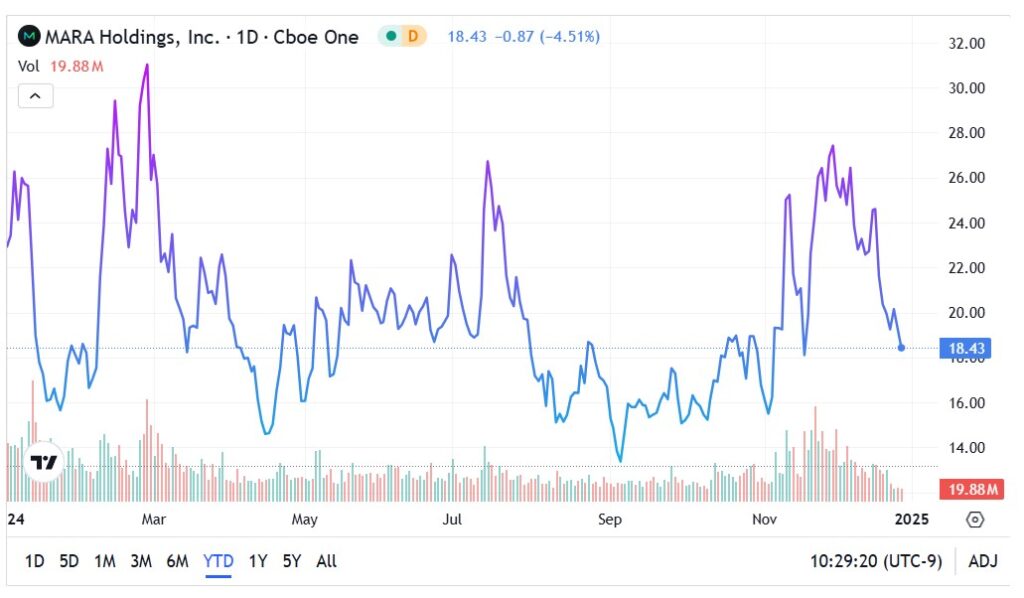The end of the holiday week encountered volatility, with the major U.S. indices suffering conspicuous declines. In turn, the cryptocurrency ecosystem was muted, extending a soft spell that began around a week-and-a-half ago. Unfortunately for investors of crypto miners like MARA Holdings MARA, the downturn also impacted the business end of the blockchain. However, contrary to popular belief, speculators should consider refraining from buying the dip.
Of course, the temptation is understandable. At the beginning of this week, Benzinga’s unusual options activity screener identified a substantial volume of bearish activity against MARA stock. Specifically, the biggest transaction among the whales — or institutional investors — was for $8 put options expiring Jan. 16, 2026. That implies about a 57% implosion from the time-of-writing price.
Still, as the meme-stock phenomenon demonstrated, contrarian speculation can sometimes lead to big rewards. Fueling this sentiment is the fact that, at the moment, MARA stock represents one of the largest increases in short interest. Currently, MARA’s short interest stands at 25.12%, whereas the prior reading sat at 20.98%.

By aggressively piling into the long side, the contrarian bulls could theoretically panic out the bears. Structurally, in order to close out a short position, the bearish trader must execute a counterbalancing long transaction. Logically, a panicked rush of long volume could skyrocket the target security, leading to a bonanza.
Nevertheless, the empirical data doesn’t support this approach for MARA stock.
Also Read: Veteran Investor Bets Big On S&P 500 Hitting 7,000 By End Of 2025: These Sectors Could Lead The Charge
Dynamic Probability Analysis Reveals a Surprising Outcome
In baseball, knowing a player’s batting average over the past few seasons is only partially useful. What’s more beneficial to managers is understanding a player’s tendencies in key situations, such as the batting average when there are runners in scoring position. Great athletes naturally rise to the occasion and this philosophy applies to Wall Street as well.
Over the past five years, the likelihood that any given week will end in a positive return comes out to 50.2%. This figure is calculated by taking the number of positive weeks over the total number of weeks in the given dataset (i.e. trailing five years). However, this simple frequentist calculation doesn’t reveal much, similar to the utility of a batting average over a full season.
Instead, it’s better to apply a dynamic probability analysis by understanding how MARA stock responds to extreme volatility. As of this writing, MARA is on pace to record a five-day loss of around 7%. Using this metric as the “anchor,” an investor can calculate how such a volatile event impacts the probability of the following week.
In the blockchain miner’s case, over the past five years, there have been 89 instances when MARA stock incurred a 7% loss or worse. Of this tally, 44 subsequent weeks recorded a positive return or a success ratio of 49.44%. Practically speaking, aberrant volatility offers no reliable indicator beyond a coin toss as to whether or not MARA will immediately rise.
However, when the blockchain miner offers a positive response week, the average return comes out to 18.2%. On the flipside, a negative response week yields an average loss of 13.2%. By extracting this critical intelligence, traders can make an informed decision about a potentially appropriate options strategy.
A Long Iron Condor Trade Beckons for MARA Stock
Although the immediate direction of MARA stock is not statistically clear, the empirical data reveals that there is a good chance of significant mobility. Therefore, investors may consider a directionally neutral strategy called the long iron condor.
Structurally a combination of a bull call spread and a bear put spread, the central idea is that the participating trader anticipates unusual kinesis in either direction. Of the four legs of the long iron condor, the trader is betting that the target security can rise to the uppermost strike price (or the bull call spread’s short strike) or fall to the lowermost strike price (or the bear put spread’s short strike).
For the unaccustomed trader, picking a long iron condor is a frustrating guessing game. However, thanks to the aforementioned dynamic probability analysis, investors can apply data-driven intelligence to their transactions. Specifically, integrating the average upside and downside (assuming a weekly 7% loss) to the current share price reveals a projected range between $16.08 and $21.89 by the end of the following week.
From here, it’s about finding the best fit within the broader context of the trader’s risk tolerance. For instance, an investor could find a long iron condor expiring next Friday (Jan. 3) where the lowermost and uppermost strike prices are $16 and $22, respectively. However, there’s no guarantee that MARA will hit these figures; the aforementioned calculations are based on probabilities, not certainties.
For a slightly more conservative trade, one might consider the 17P | 18P || 20C | 21C condor or the 17/18 bear put spread combined with the 20/21 bull call spread. To receive the maximum payout, MARA stock needs to rise to $21 or fall to $17. While still risky, it’s a comparatively more realistic trade.
Read Next:
Photo: Shutterstock
© 2024 Benzinga.com. Benzinga does not provide investment advice. All rights reserved.